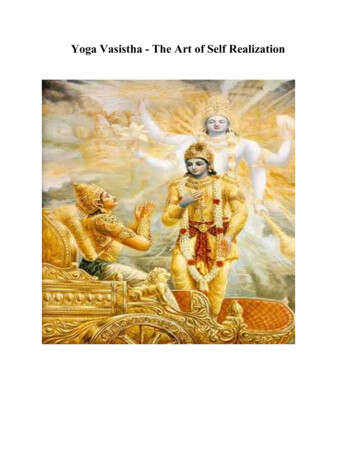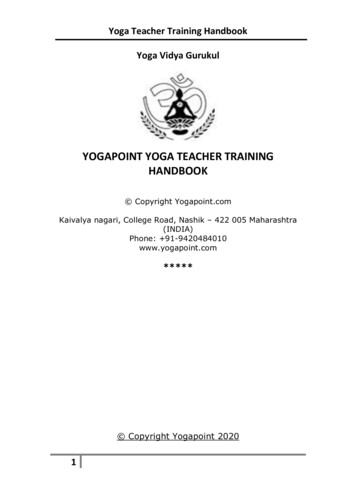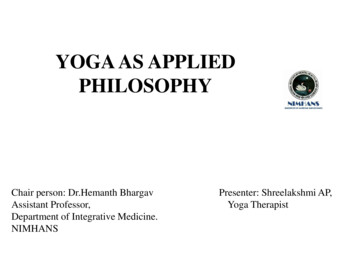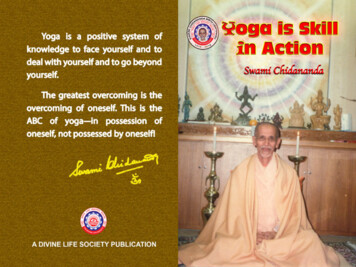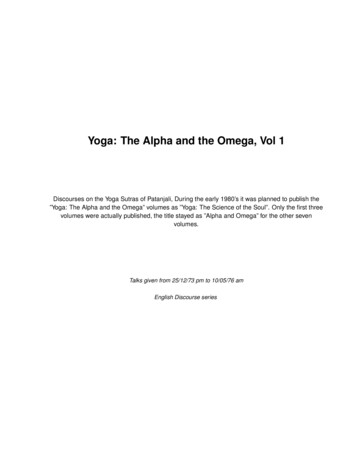
Transcription
YOGA SŪTRASof PatañjaliYogi Madhvācārya / Michael Beloved
2YOGA SŪTRASCopyright 2007 --- Michael BelovedAll rights reservedTransmit/ Reproduce/ Quote with author’s consent only.ISBN :978-1-4357-1246-1Library of Congress Control Number :2008902438
3LORD SHIVA – Master of the Yogis
4YOGA SŪTRASEDITORIAL CREDITSComputer Formatting Editor:Advisory Editor.Final Editor:Computer Consultant.Front-Back Cover/Shiva Art.Krishna-Balaram logoGlossaryIndexesFINANCIAL CREDITSBhagīratha dasSir Paul CastagnaAuthorRaymond GrantSir Paul CastagnaSundarananda devi dasiBhagīratha dasAuthorBhagīratha das,Curt Simon, Surya das,Christopher Hall,Dear Beloved,Bharat Patel.CorrespondenceBook OrdersPaul CastagnaP.O. Box 152Iron Belt, WIUSA54536E-mail: sssix@yahoo.comIngrid Thomas-Clark3703 Foster AveBrooklyn NY 11203USAMichael Beloved13 Goodhope, Canal No.1West Bank DemeraraGUYANAHARE KRISHNAKRISHNAHAREHARE RAMARAMAHAREHARE KRISHNAKRISHNAHAREHARE exus@gmail.com
5TABLE OF CONTENTSIntroduction7Part 1Yoga Sūtras: Verses and Translation9Chapter 1Samādhi Pāda: Transcendence Accomplishment11Chapter 2Sādhana Pāda: Practice Accomplishment21Chapter 3Vibhūti Pāda: Glory Displayed32Chapter 4Kaivalya Pāda: Segregation Accomplished45Part 2An Approach to Patañjali’s Yoga Sūtras53Chapter 1Samādhi Pāda: Transcendence Accomplishment55Chapter 2Sādhana Pāda: Practice Accomplishment60Chapter 3Vibhūti Pāda: Glory Displayed67Chapter 4Kaivalya Pāda: Segregation Accomplished73
6YOGA SŪTRASPart 3Yoga Sūtra: Verses, Translation and Commentary79Chapter 1Samādhi Pāda: Transcendence Accomplishment81Chapter 2Sādhana Pāda: Practice Accomplishment116Chapter 3Vibhūti Pāda: Glory Displayed149Chapter 4Kaivalya Pāda: Segregation Accomplished187Glossary with Word-for-Word Meanings205Index to Verses: Selected Sanskrit Words219Index to Verses: Selected English Words223Index to Commentary of Part 3229Scheme of Pronunciation238About the Author239
7IntroductionAnyone who does not have a basic knowledge of sanskrit is at adisadvantage when studying a translation. This is because the reader isat the mercy of the translator and is liable to be exploited. Texts like theBhagavad-gita and the Yoga Sūtras were and are being translated bymany writers. Each translator has a motive. If the reader is naieve, hecan hardly sort between the intentions of the original writer and theagenda of the translator.I was prompted to attempt this translation by Sir Paul Castagna, but Idid have some schooling in the practice of this yoga by SrilaYogeshwarananda, one of my yoga gurus. He showed me much in theastral dimensions. I must admit however that until Sir Paul brought it tomy attention, I did not regard the implications of these sūtras for modernpeople. The question remains: What was my motive in the translation?I may evade that by stating that I did this without motive just after SirPaul asked me to translate. However, it is true that even a motivelesstranslator develops a particular interest and loads that into his translationas he proceeds. My interest was a curiosity to see exactly what SriPatañjali expounded. I was to an extent shocked at his crudepronouncements and his total disregard for the psychosis or disorderedand uncontrolled mental and emotional status of an average humanbeing.With all due respects to Patañjali, his sanskrit text and my translationis presented first. Then a simplification entitled “An Approach toPatañjali’s Yoga Sūtras” is given.And at last the text, theword-for-word meanings, the translation and a commentary is presented.I would suggest however, that readers tackle the second part first,that is the approach to the sūtras. Then read the first part, the actualtranslation. Then study the third part, which is the translation and mycommentary. And always remember that Patañjali’s ideas cannot beutilized except through the practice of yoga.Mdv.
8YOGA SŪTRAS
Part 1Yoga Sūtras:Verses and Translation
10YOGA SŪTRAS
Verses and TranslationCHAPTER 1: SAMĀDHI PĀDATranscendence AccomplishmentVerse 1Aw yaeganuzasnmatha yogānuśāsanamNow I give the explanation of yoga and its practice.Verse 2yaegiíÄv&iÄinraex yogaḥ cittavṛtti nirodhaḥThe skill of yoga is demonstratedby the conscious non-operation of the vibrational modes of the mentoemotional energy.Verse 3tda Ôòu Svêpe vSwanm!tadā draṣṭuḥ svarūpe avasthānamThen the perceiver is situated in his own form.Verse 4v&iÄsaêPyimtrÇvṛtti sārūpyam itaratraAt other times, there is conformitywith the mento-emotional energy.Verse 5v&Äy pÂtYy i òa i òa vṛttayaḥ pañcatayyaḥ kliṣṭā akliṣṭāḥThe vibrations in the mento-emotional energyare five-fold being agonizing or none-troublesome.11
12YOGA SŪTRASVerse 6àma[ivpyRyivkLpinÔaSm&ty pramāṇa viparyaya vikalpa nidrā smṛtayaḥThey are correct perception, incorrect perception,imagination, sleep and memory.Verse 7àTy]anumanagma àma[ainpratyakṣa anumāna āgamāḥ pramāṇāniCorrect perception may be acquired directly,by correct analysis or by correct reference.Verse 8ivpyRyae imWya}anmtÔUpàitòm!viparyayaḥ mithyājñānam atadrūpa pratiṣṭhamIncorrect perception is based on false informationand on perception of what is not the true form.Verse 9zBd}ananupatI vStuzUNyae ivkLp śabdajñāna anupātī vastuśūnyaḥ vikalpaḥVerbal or written informationwhich is followed by conceptswhich are devoid of reality, is imagination.Verse 10AÉavàTyyalMbna v&iÄinRÔaabhāva pratyaya ālambanā vṛttiḥ nidrāSleep is the vibrationial mode which is supportedby the absence of objective awareness.Verse 11AnÉUtiv;yasMàmae; Sm&it anubhūta viṣaya asaṁpramoṣaḥ smṛtiḥMemory is the retained impression of experienced objects.
Verses and TranslationVerse 12A yasvEraGya ya tiÚraex abhyāsa vairāgyābhyāṁ tannirodhaḥThat non-operation of the vibrational modesis achieved by effective practice in not having an interestin the very same operations.Verse 13tÇ iSwtaE yÆae yas tatra sthitau yatnaḥ abhyāsaḥIn that case, practice is the persistent endeavor(to cultivate that lack of interest).Verse 14s tu dI"RkalnErNtyRsTkaraseivtae †FÉUim sa tu dīrghakāla nairantaryasatkāra āsevitaḥ dṛḍhabhūmiḥBut that is attained on the firm basisof a continuous reverential sustained practicewhich is executed for a long time.Verse 15†òanuïivkiv;yivt&:[Sy vzIkarsÁ}a vEraGym!dṛṣṭa ānuśravika viṣaya vitṛṣṇasyavaśīkārasaṁjñā vairāgyamThe non-interest in the operationsof the mento-emotional energy is achievedby one who has perfect mastery in consciousnessand who does not cravefor what is perceived or what is heard ofin the mundane existence.Verse 16tTpr pué;OyateguR[vEt&:[am!tatparaṁ puruṣakhyāteḥ guṇavaitṛṣṇyamThat highest non-interest occurs when there isfreedom from desire for the features of material natureand thorough awareness of the spiritual person.13
14YOGA SŪTRASVerse 17ivtkRivcaranNdaiSmtaêpanugmat! sMà}at vitarka vicāra ānanda asmitārūpa anugamāt saṁprajñātaḥThe observational linkage of the attentionto a higher concentration force occurs with analysis,reflection and introspective happinessor with focus on self-consciousness.Verse 18ivramàTyya yaspUvR s Skarze;ae ny virāmapratyaya abhyāsapūrvaḥ saṁskāraśeṣaḥ anyaḥThe other state is the complete departurefrom the level where the remaining impressionslie in the mento-emotional energy.Verse 19ÉvàTyyae ivdehàk«itlyanambhavapratyayaḥ videha prakṛtilayānāmOf those who are diffused into subtle material natureand those who existing in a bodiless state,their psychology has that content.Verse 20ïÏavIyRSm&itsmaixà}apUvRk #tre;am!śraddhā vīrya smṛti samādhiprajñā pūrvakaḥ itareṣāmFor others, confidence, stamina, introspective memory,the continuous effortless linkage of the attentionto a higher concentration force, and profound insight,all being previously mastered, serves as the cause.Verse 21tIìs veganamasÚ tīvrasaṁvegānām āsannaḥFor those who practice forcefully in a very intense way,the skill of yoga will be achieved very soon.
Verses and TranslationVerse 22m&ÊmXyaixmaÇTvaÄtae ip ivze; mṛdu madhya adhimātratvāt tataḥ api viśeṣaḥThen there is even more ratings,according to intense, mediocre, or slight practice.Verse 23 ñrài[xanaÖaĪśvara praṇidhānāt vāOr by the method of profound religious meditationupon the Supreme Lord.Verse 24 ezkmRivpakazyErpram&ò pué;ivze; ñr kleśa karma vipāka āśayaiḥaparāmṛṣṭaḥ puruṣaviśeṣaḥ ĪśvaraḥThe Supreme Lord is that special personwho is not affected by troubles, actions, developmentsor by subconscious motivations.Verse 25tÇ inritzy svR}vIjm!tatra niratiśayaṁ sarvajñabījamThere, in Him, is found the unsurpassed origin of all knowledge.Verse 26s @; pUvRe;amip gué kalenanvCDedat!sa eṣaḥ pūrveṣām api guruḥ kālena anavacchedātHe, this particular person, being unconditioned by timeis the guru even of the ancient teachers,the authorities from before.Verse 27tSy vack à[v tasya vācakaḥ praṇavaḥOf Him, the sacred syllable Āuṁ (Om) is the designation.15
16YOGA SŪTRASVerse 28t¾pStdwÉavnm!tajjapaḥ tadarthabhāvanamThat sound is repeated, murmured constantlyfor realizing its meaning.Verse 29tt àTy‹etnaixgmae PyNtrayaÉavítataḥ pratyakcetana adhigamaḥ api antarāya abhāvaḥ caAs a result there is inwardness of the sense consciousnessand the disappearance of obstacles to progress.Verse 30VyaixSTyans zyàmadalSyaivritæaiNtdzRnalBxUimkTvanviSwtTvain icÄiv]epaSte Ntraya vyādhi styāna saṁśaya pramāda ālasya avirati bhrāntidarśanaalabdhabhūmikatva anavasthitatvāni cittavikṣepaḥ te antarāyāḥThese obstacles are disease, idleness, doubt, inattentiveness,lack of energy and proneness to sensuality, mistaken views,not being able to maintain the progress attained,unsteadiness in progression,scattered mental and emotional energy.Verse 31Ê odaEMmRnSya¼mejyTvñasàñasa iv]epshÉuv duḥkha daurmanasya aṅgamejayatvaśvāsapraśvāsāḥ vikṣepa sahabhuvaḥDistress, depression, nervousness and labored breathingare the symptoms of a distracted state of mind.Verse 32tTàit;exawRmektÅva yas tatpratiṣedhārtham ekatattva abhyāsaḥFor the removal of the obstacles,there should be the practice of a standard methodused in the pursuit of the reality.
Verses and TranslationVerse 33mEÇIké[amuidtaepe]a[a suoÊ opu{yapu{yiv;ya[aMÉavnatiíÄàsadnm!maitrī karuṇā muditā upekṣaṇamsukha duḥkha puṇya apuṇyaviṣayāṇāṁ bhāvanātaḥ cittaprasādanamThe abstract meditationresulting from the serenity of the mento-emotional energy,comes about by friendliness, compassion, cheerfulnessand non-responsiveness to happiness, distress, virtue and vice;Verse 34àCDÎRnivxar[a ya va àa[Sypracchardana vidhāraṇābhyāṁ vā prāṇasyaor by regulating the exhalation and inhalation of the vital energy;Verse 35iv;yvtI va àv«iÄéTpÚa mns iSwitinbNxnIviṣayavatī vā pravṛttiḥ utpannā manasaḥ sthiti nibandhanīor by fusion and steadiness of the mind which is producedby the operation of the mento-emotional energytowards an object which is different to,but similar to a normal thing;Verse 36ivzaeka va Jyaeit:mtIviśokāh vā jyotiṣmatīor by sorrow-less and spiritually-luminous states;Verse 37vItragiv;y va icÄm!vītarāga viṣayaṁ vā cittamor by fixing the mento-emotional energyon someone who is without craving;17
18YOGA SŪTRASVerse 38SvßinÔa}analMbn vasvapna nidrā jñāna ālambanaṁ vāor by taking recourse to dream or dreamless sleep.Verse 39ywaiÉmtXyanaÖayathābhimata dhyānāt vāOr it can be achieved from the effortless linkage of the mindto a higher concentration force which was dearly desired.Verse 40prma[uprmmhÅvaNtae Sy vzIkar paramāṇu paramamahattvāntaḥ asya vaśīkāraḥThe mastery of his psyche results in control of his relationshipto the smallest atom or to cosmic proportions.Verse 41]I[v&ÄeriÉjatSyev m[e RhIt& h[ aýe;u tTSwtdÃnta smapiÄ kṣīṇavṛtteḥ abhijātasya iva maṇeḥ grahītṛgrahaṇa grāhyeṣu tatstha tadañjanatā samāpattiḥIn regards to the great reductionof the mento-emotional operations,there is fusion of the perceiver, the flow of perceptionsand what is perceived, just like the absorption of a transparent jewel.Verse 42tÇ zBdawR}anivkLpE s»I[aR sivtkaR smapiÄ tatra śabda artha jñāna vikalpaiḥsaṅkīrṇā savitarkā samāpattiḥIn that case,the deliberate linkage of the mento-emotional energyto a higher concentrating force occurswhen a word, its meaning and the knowledge of the objectalternate within the mind, blending as it were.
Verses and TranslationVerse 43Sm&itpirzuÏaE SvêpzUNyevawRmaÇinÉaRsa inivRtkaRsmṛtipariśuddhau svarūpaśūnya ivaarthamātranirbhāsā nirvitarkaNon-analytical linkage of his attentionto a higher concentration force occurswhen the memory is completely purifiedand the essential inquiring nature disappears as it were,such that the value of that higher force shines through.Verse 44@tyEv sivcara inivRcara c sUúmiv;ya VyaOyataetayaiva savicāra nirvicāra ca sūkṣmaviṣayā vyākhyātāBy this, the investigative and non-investigative linkageof one’s attention to a higher concentration forceconsisting of subtler objects, was explained.Verse 45sUúmiv;yTv cail¼pyRvsanm!sūkṣmaviṣayatvaṁ ca aliṅga paryavasānamThe insight into the subtle nature of gross objectsterminates when one becomes linkedto the higher concentration force which has no characteristics.Verse 46ta @v svIj smaix tā eva sabījaḥ samādhiḥThe previous descriptions concern the effortlessand continuous linkage of the attentionto a higher concentration force,as motivated by the mento-emotional energy.19
20YOGA SŪTRASVerse 47inivRcarvEzar*e XyaTmàsad nirvicāra vaiśāradye adhyātmaprasādaḥOn gaining competence in the non-investigative linkageof one’s attention to the higher concentration force,one experiences the clarity and serenity which resultsfrom the linkage of the Supreme Soul and the limited one.Verse 48\tMÉra tÇ à}aṛtaṁbharā tatra prajñāThere with that competence,the yogin develops the reality-perceptive insight.Verse 49ïutanumanà}a yamNyiv;ya ivze;awRTvat!śruta anumāna prajñābhyām anyaviṣayā viśeṣārthatvātIt is different from the two methods of insightwhich are based on what is heardand what is reasoned out, because that is limitedto a particular aspect of an object.Verse 50t¾ s Skarae Nys SkaràitbNxItajjaḥ saṁskāraḥ anyasaṁskāra pratibandhīThat impression which is producedfrom the reality-perceptive insight,acts as the preventer of the other impressions.Verse 51tSyaip inraeexe svRinraexaiÚvIRjSsmaix tasyāpi nirodhe sarvanirodhāt nirbījaḥ samādhiḥThe continuous effortless linkage of the attentionto the higher concentration force which is not motivatedby this mento-emotional energy,occurs when there is a non-operation,even of that preventative impressionwhich caused the suppression of all other lower memories
Verses and TranslationCHAPTER 2: SĀDHANA PĀDAPractice AccomplishmentVerse 1tp SvaXyayeñrài[xanain i³yayaeg tapaḥ svādhyāya Īśvarapraṇidhānāni kriyāyogaḥAusterity, study of the psyche,profound religious meditation on the Supreme Lordis the dynamic kriya yoga practice.Verse 2smaixÉavnawR eztnUkr[awRísamādhi bhāvanārthaḥ kleśa tanūkaraṇārthaś caIt is for the purpose of producingcontinuous effortless linkage of the attentionto a higher concentration force and for causingthe reduction of the mental and emotional afflictions.Verse 3Aiv*a iSmtaragÖe;aiÉinveza p eza avidyā asmitā rāga dveṣa abhiniveśaḥ pañca kleśāḥThe mental and emotional afflictionsare spiritual ignorance, misplaced identity,emotional attachment, impulsive-emotional disaffectionand the strong focus on mundane existence,which is due to an instinctive fear of death.Verse 4Aiv*a ]eÇmuÄre;a àsuÝtnuiviCDÚaedara[am!avidyā kṣetram uttareṣāṁprasupta tanu vicchina udārāṇāmSpiritual ignorance is the existential environmentfor the other afflictions, in their dormant, reduced,periodic or expanded stages.21
22YOGA SŪTRASVerse 5AinTyazuicÊ oanaTmsu inTyzuicsuoaTmOyaitriv*aanitya aśuci duḥka anātmasu nitya śucisukha ātma khyātiḥ avidyāSpiritual ignorance is exhibited when what is temporary,impure, distressful and mundane, is identifiedas being eternal, pure, joyful and spiritual respectively.Verse 6†GdzRnzKTyaerekaTmteva iSmtadṛg darśanaśaktyoḥ ekātmatā iva asmitāMistaken identity occurs when the supernatural visionand what is seen through it seems to be identical.Verse 7suoanuzyI rag sukha anuśayī rāgaḥCraving results from a devoted attachment to happiness.Verse 8Ê oanuzyI Öe; duḥkha anuśayi dveṣaḥImpulsive emotional disaffection resultsfrom a devoted attachment to distress.Verse 9SvrsvahI ivÊ;ae ip twaêFae iÉinvez svarasavāhī viduṣaḥ ’pi tatha rūḍho ‘bhiniveśaḥAs it is, the strong focus on mundane existence,which is due to the instinctive fear of death,and which is sustained by its own potencies,which operates for self preservation,is developed even in the wise man.
Verses and TranslationVerse 10te àitàsvheya sUúma te pratiprasavaheyāḥ sūkṣmāḥThese subtle motivations are to be abandonedby reverting their expressions backwards.Verse 11XyanheyaStÖ Äy dhyānaheyāḥ tadvṛttayaḥTheir vibrational modes are to be abandoned or ceasedby the effortless linkage of the attentionto a higher concentration force or person.Verse 12 ezmUl kmaRzyae †òjNmvednIy kleśamūlaḥ karmāśayaḥ dṛṣṭa adṛṣṭa janma vedanīyaḥThe psychological storage of the impressionsleft by performance of cultural activitieswhich is itself the cause of the mentaland emotional distress, is experiencedin realized and non-realized births.Verse 13sit mUle tiÖpakae jaTyayÉaegR a sati mūle tadvipākaḥ jāti āyuḥ bhogāḥIn the case aforementioned, there exists the resulting effectswhich manifest as a particular species of lifewith certain duration of body and type of experiencesgained in that form.Verse 14te ’adpirtap)la pu{yapu{yhetTu vat!te hlāda paritāpa phalāḥ puṇya apuṇya hetutvātThey produce happiness and distress as results,on the basis of merit and demerits.23
24YOGA SŪTRASVerse 15pir[amtaps SkarÊ oEguR[v&iÄivraexa½ Ê omev sv¡ ivveikn pariṇāma tāpa saṁskāra duḥkaiḥ guṇavṛttivirodhāt ca duḥkham eva sarvaṁ vivekinaḥThe discriminating person knowsthat all conditions are distressfulbecause of circumstantial changes, strenuous endeavor, impulsivemotivations, clashing aspectsand the vibrational modes of the mento-emotional energy.Verse 16hey Ê omnagtm!heyaṁ duḥkham anāgatamDistress which is not manifested is to be avoided.Verse 17Ôò&†Zyyae s yaegae heyhetu draṣṭṛdṛśyayoḥ saṁyogo heyahetuḥThe cause which is to be avoided is the indiscriminateassociation of the observer and what is perceived.Verse 18àkazi³yaiSwitzIl ÉUteiNÔyaTmk ÉaegapvgaRw¡ †Zym!prakāśa kriyā sthiti śīlaṁ bhūtendriyātmakaṁ bhogāpavargārthaṁdṛśyamWhat is perceived is of the natureof the mundane elements and the sense organsand is formed in clear perception, action or stability.Its purpose is to give experience or to allow liberation.Verse 19ivze;aivze;il¼maÇail¼ain gu[pvaRi[viśeṣa aviśeṣa liṅgamātra aliṅgāni guṇaparvāṇiThe phases of the influences of material natureare those which are specific, regular, indicated or not indicated.
Verses and TranslationVerse 20Ôòa †izmaÇ zuÏae ip àTyyanupZy draṣṭā dṛśimātraḥ śuddhaḥ api pratyayānupaśyaḥThe perceiver is the pure extent of his consciousnessbut his conviction is patterned by what is perceived.Verse 21tdwR @v †ZySyaTmatadarthaḥ eva dṛśyasya ātmaThe individual spirit who is involved in what is seen,exists here for that purpose only.Verse 22k«taw¡ àit nòmPynò tdNysaxar[Tvat!kṛtārthaṁ prati naṣṭam apianaṣṭaṁ tadanya sādhāraṇatvātIt is not effective for one to whom its purpose is fulfilledbut it has a common effect on the others.Verse 23SvSvaimz yae SvêpaepliBxhetu s yaeg sva svāmiśaktyoḥ svarūpa upalabdhi hetuḥ saṁyogaḥThere is a reason for the conjunction of the individual selfand his psychological energies. It is for obtainingthe experience of his own form.Verse 24tSy hetru iv*atasya hetuḥ avidyāThe cause of the conjunction is spiritual ignorance.25
26YOGA SŪTRASVerse 25tdÉavat! s yaegaÉavae han tÎ ze kEvLym!!tad abhāvāt saṁyogā abhāvaḥ hānaṁ taddṛśeḥ kaivalyamThe elimination of the conjunction which resultsfrom the elimination of that spiritual ignoranceis the withdrawal that is the total separationof the perceiver from the mundane psychology.Verse 26ivvekOyaitrivPlva hanaepay vivekakhyātiḥ aviplavā hānopāyaḥThe method for avoiding that spiritual ignoranceis the establishment of continuous discriminative insight.Verse 27tSy sÝxa àaNtÉUim à}atasya saptadhā prāntabhūmiḥ prajñāConcerning the development of his discriminative insight,there are seven stages.Verse 28yaega¼anuóanadzuiÏ]ye }andIiÝraivvekOyate yogā ṅgānuṣṭhānāt aśuddhikṣayejñānadīptiḥ āvivekakhyāteḥFrom the consistent practice of the parts of the yoga process,on the elimination of the impurity,the radiant organ of perception becomes manifest,until there is steady discriminative insight.
Verses and TranslationVerse 29yminymasnàa[ayamàTyaharxar[aXyansmaxyae òav¼ainyama niyama āsana prāṇāyāma pratyāhāradhāraṇā dhyāna samādhayaḥ aṣṭau aṅgāniMoral restrains, recommended behaviors, body posture,breath enrichment, sensual energy withdrawal,linking of the attention to higher concentration forces or persons,effortless linkage of the attentionto higher concentration forces or persons,continuous effortless linkage of the attentionto higher concentration forces or persons,are the eight parts of the yoga system.Verse 30Aih sasTyaSteyäücyaRpir ha yma ahiṁsā satya asteya brahmacarya aparigrahāḥ yamāḥNon-violence, realism, non-stealing, sexual non-expressivenesswhich results in the perception of spirituality (brahman)and non-possessiveness, are the moral restraints.Verse 31jaitdezkalsmyanviCDÚa savÉaEma mhaìtm!jāti deśa kāla samaya anavacchinnāḥsārvabhaumāḥ mahāvratamThose moral restraints are not to be adjustedby the status, location, time and condition.They are related to all stages of yoga, being the great commitment.Verse 32zaEcsNtae;tp SvaXyayeñrài[xanain inyma śauca saṅtoṣa tapaḥ svādhyāya īśvarapraṇidhānāni niyamāḥPurification, contentment, austerityand profound religious meditation on the Supreme Lordare the recommended behaviors.27
28YOGA SŪTRASVerse 33ivtkRbaxne àitp]Éavnm!!vitarkabādhane pratipakṣabhāvanamIn the case of the annoyance produced by doubts,one should conceive of what is opposite.Verse 34ivtkaR ih sady k«tkairtanumaeidta laeɳaexmaehpUvRkam&ÊmXyaixmaÇaÊ oa}ananNt)la #it àitp]Éavnm!vitarkaḥ hiṁsādayaḥ kṛta kārita anumoditāḥ lobha krodha mohapūrvakaḥ mṛdu madhya adhimātraḥ duḥkha ajñāna anantaphalāḥiti pratipakṣabhāvanamDoubts which produce violence and related actions,which are performed, caused to be done or endorsed,and which are caused by greed, anger and delusion,even if minor, mediocre or substantial,cause endless distress and spiritual ignorance as the results. Therefore,one should consider the opposite features.Verse 35Aih saàitóaya tTsiÚxaE vErTyag ahiṁsāpratiṣṭhāyāṁ tatsannidhau vairatyāgaḥOn being firmly established in non-violence,the abandonment of hostility occurs in his presence.Verse 36sTyàitóaya i³ya)laïyTvm!satyapratiṣṭhāyāṁ kriyāphalāśrayatvamOn being established in realism,his actions serve as a basis for results.Verse 37ASteyàitóaya svRrÆaepSwanm!asteyapratiṣṭhāyāṁ sarvaratnopasthānamOn being firmly established in non-sealing,all precious things wait to serve a yogin.
Verses and TranslationVerse 38äücyRàitóaya vIyRlaÉ brahmacaryapratiṣṭhāyāṁ vīryalābhaḥOn being firmly established in the sexual non-expressiveness, whichresults in the perception of spirituality, vigor is gained.Verse 39Apir hSwEyeR jNmkwNtasMbaex aparigrahasthairye janmakathaṁtā saṁbodhaḥIn being consistent in non possessiveness, there is manifestedthe reason and the correct perception regarding one’s birth.Verse 40zaEcaTSva¼juguPsa prErs sgR śaucāt svāṅgajugupsā paraiḥ asaṁsargaḥFrom purification comes a disgust for one’s own bodyand a lack of desire to associate with others.Verse 41sÅvzuiÏsaEmnSyEka !(eiNÔyjyaTmdzRnyaeGyTvain csattvaśuddhi saumanasya ekāgra indriyajayaātmadarśana yogyatvāni caPurification of the psyche results in benevolence,the ability to link the attention to one concentration forceor person, conquest of the sensual energy, vision of the spiritand fitness for abstract meditation.Verse 42sNtae;adnuÄmsuolaÉ saṅtoṣāt anuttamaḥ sukhalābhaḥFrom contentment, the very best in happiness is obtained.29
30YOGA SŪTRASVerse 43kayeiNÔyisiÏrzuiÏ]yaÄps kāya indriya siddhiḥ aśuddhikṣayāt tapasaḥAusterity, resulting in the elimination of impurityproduces perfection of the body and sensual energy.Verse 44SvaXyayaidòdevtasMàyaeg svādhyāyāt iṣṭadevatā saṁprayogaḥFrom study of the psyche, comes intimate contactwith the cherished divine being.Verse 45smaixisiÏrIñrài[xanat!samādhisiddhiḥ īśvarapraṇidhānātFrom the profound religious meditationupon the Supreme Lord comes the perfectionof continuous effortless linkage of the attention to that Divinity.Verse 46iSwrsuomasnm!sthira sukham āsanamThe posture should be steady and comfortable.Verse 47àyÆzEiwLyanNtsmapiÄ yam!prayatna śaithilya ananta samāpattibhyāmIt results in relaxation of effort and the meeting with the infinite.Verse 48ttae ÖNÖaniÉ"at tataḥ dvandvāḥ anabhighātaḥFrom then on, there are no botherationsfrom the dualities like happiness and distress, heat and cold.
Verses and TranslationVerse 49tiSmNsit ñasàñasyaegRitivCDed àa[ayam tasmin satiśvāsa praśvāsayoḥ gativicchedaḥ prāṇāyāmaḥOnce this is accomplished, breath regulation,which is the separation of the flow of inhalation and exhalation,is attained.Verse 50vaýa yNtrStMÉv&iÄdeRzkals'œOyaiÉ pir†òae dI"RsúU m bāhya ābhyantara stambha vṛttiḥ deśa kālasaṁkhyābhiḥ paridṛṣṭah dīrgha sūkṣmaḥIt has internal, external and restrictive operations,which are regulated according to the place, timeand accounting, being prolonged or hardly noticed.Verse 51vaýa yNtriv;ya]epI ctuwR bāhya ābhyantara viṣaya ākṣepī caturthaḥThat which transcendsthe objective external and internal breath regulationis the fourth type of pranayama.Verse 52tt ]Iyte àkazavr[m!tataḥ kṣīyate prakāśa āvaraṇamFrom that is dissipated, the mental darkness which veils the light,Verse 53xar[asu c yaeGyta mns dhāraṇāsu ca yogyatā manasaḥ. and from that, is attained the state of the mindfor linking the attentionto a higher concentration force or person.31
32YOGA SŪTRASVerse 54Sviv;yasMàyaege icÄSy Svêpanukar #veiNÔya[a àTyahar svaviṣaya asaṁprayoge cittasya svarūpāanukāraḥiva indriyāṇāṁ pratyāhāraḥThe withdrawal of the senses is as it were,their assumption of the form of mento-emotional energywhen not contacting their own objects of perception.Verse 55tt prma vZyteiNÔya[am!!tataḥ paramā vaśyatā indriyāṇāmFrom that accomplishment, comes the highest degreeof control of the senses.CHAPTER 3: VIBHŪTI PĀDAGlory DisplayedVerse 1dezbNxiíÄSy xar[adeśa bandhaḥ cittasya dhāraṇāLinking of the attention to a concentration forceor person, involves a restricted locationin the mento-emotional energy.Verse 2tÇ àTyyEktanta Xyanm!tatra pratyaya ekatānatā dhyānamWhen in that location,there is one continuous threadlike flowof one’s instinctive interest that is the effortless linkingof the attention to a higher concentration force or person.
Verses and TranslationVerse 3tdevawRmaÇinÉaRs SvêpzUNyimv smaix tadeva arthamātranirbhāsaṁsvarūpaśūnyam iva samādhiḥThat same effortless linkage of the attentionwhen experienced as illuminationof the higher concentration force or person,while the yogi feels as if devoid of himself,is samadhi or continuous effortless linkage of his attentionto the special person, object, or force.Verse 4ÇymekÇ s ym trayam ekatra saṁyamaḥThe three as one practice is the complete restraint.Verse 5t¾yaTà}alaek tajjayāt prajñālokaḥFrom the mastery of that complete restraintof the mento-emotional energy, one develops the illuminating insight.Verse 6tSy ÉUim;u ivinyaeg tasya bhūmiṣu viniyogaḥThe practice of this complete restraint occurs in stages.Verse 7ÇymNtr¼ pUveR y trayam antaraṅgaṁ pūrvebhyaḥIn reference to the preliminary stages of yoga,these three higher states concern the psychological organs.33
34YOGA SŪTRASVerse 8tdip vihrNg invIRjSytadapi bahiraṅgaṁ nirbījasyaBut even that initial mastershipof the three higher stages of yoga,is external in reference to meditation,which is not motivated by the mento-emotional energy.Verse 9VyuTwaninraexs SkaryaeriÉÉvàaÊÉaRvaE inraex][icÄaNvyae inraexpir[am vyutthāna nirodha saṁskārayoḥabhibhava prādurbhāvau nirodhakṣaṇacittānvayaḥ nirodhapariṇāmaḥWhen the connection with the mento-emotional energymomentarily ceases during the manifestationand disappearance phases when there is expressionor suppression of the impressions, that is the restraintof the transforming mento-emotional energy.Verse 10tSy àzaNtvaihta s Skarat!tasya praśāntavāhita saṁskārātConcerning this practice of restraint,the impressions derived cause a flow of spiritual peace.Verse 11svaRwRtEka tyae ]yaedyaE icÄSy smaixpir[am sarvārthatā ekāgratayoḥ kṣaya udayaucittasya samādhipariṇāmaḥThe decrease of varying objectives in the mento-emotional energy and theincrease of the one aspect within it,is the change noticedin the practice of continuous effortless linking of the attentionto higher concentration forces, objects or persons.
Verses and TranslationVerse 12tt pun zaNtaeidtaE tuLyàTyyaE icÄSyEka tapir[am tataḥ punaḥśānta uditau tulyapratyayau cittasya ekāgratāpariṇāmaḥThen again, when the mind’s content is the sameas it was when it is subsiding and when it is emerging,that is the transformation called“having one aspect in front of, or before the attention”.Verse 13@ten ÉUtie NÔye;u xmRl][avSwapir[ama VyaOyata etena bhūtendriyeṣu dharma lakṣaṇaavasthā pariṇāmāḥ vyākhyātāḥBy this description of changes, quality and shape,the changing conditions of the various states of matteras well as those of the sensual energy, was described.Verse 14zaNtaeidtaVypdeZyxmaRnupatI xmIRśānta udita avyapadeśya dharma anupātī dharmīWhen the collapsed, emergent and latent forcesreach full retrogression, that is the most basic condition.Verse 15³maNyTv pir[amaNyTve het ukarma anyatvaṁ pariṇāma anyatve hetuḥThe caus
Bhagavad-gita and the Yoga Sūtras were and are being translated by many writers. Each translator has a motive. If the reader is naieve, he can hardly sort between the intentions of the original writer and the agenda of the translator. I was prompte



